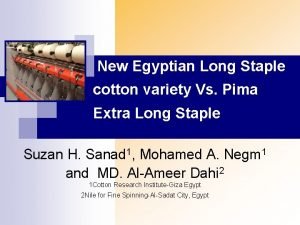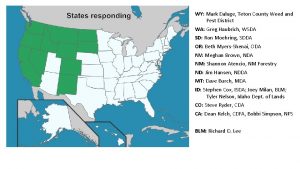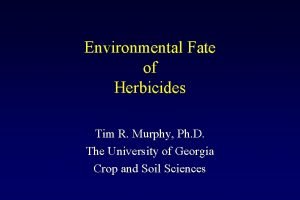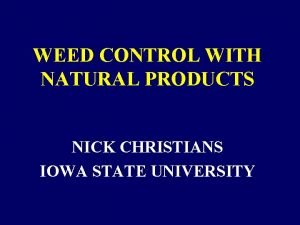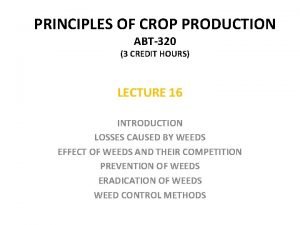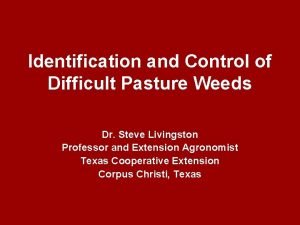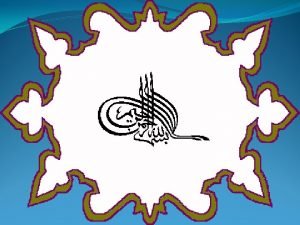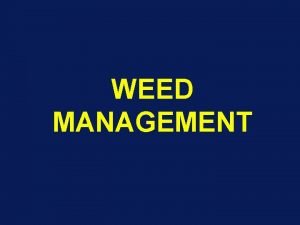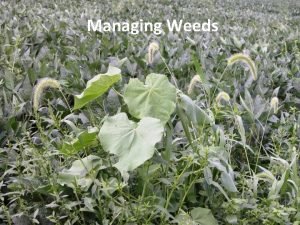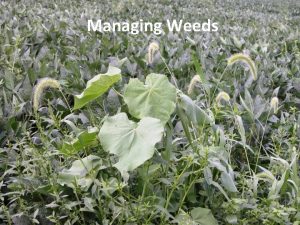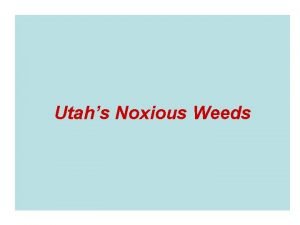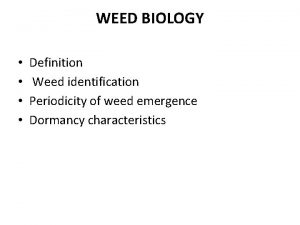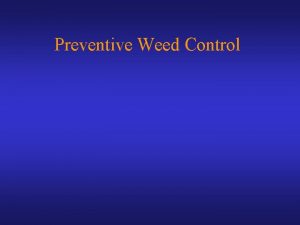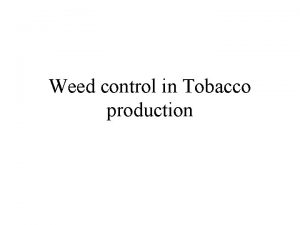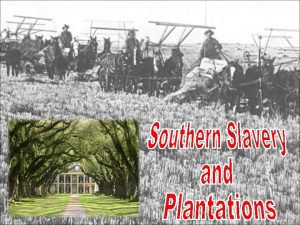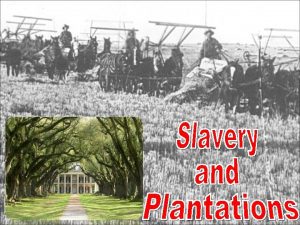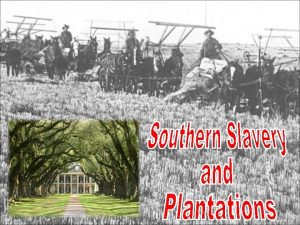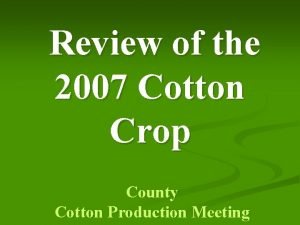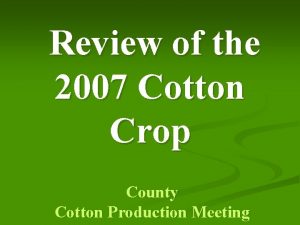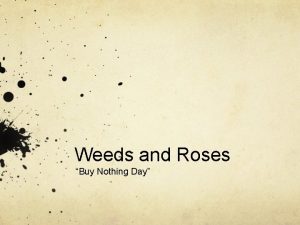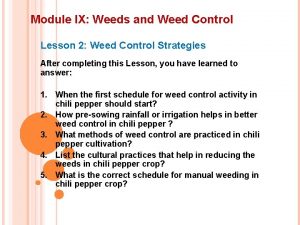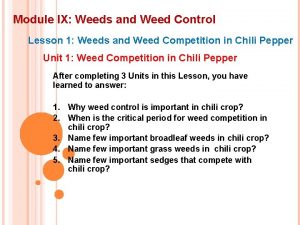Cotton Crop Weed Control Connor Day Weeds A
















- Slides: 16

Cotton Crop Weed Control Connor Day

Weeds A weed is a plant that has little or no nutritional value or any other use, for example, medicinal or textile. They can be classified as a form of plant that requires action to minimise its effect on the economy, the environment and human health. They germinate easily, have high growth rates and decrease yield. Weeds can appear in many different forms, some of these include broadleaf and grass weeds.

Impact of weeds on cotton crops A cotton farmer who doesn’t implement any type of weed control would not produce harvestable cotton. Once the cotton has been sown, it requires eight weedfree weeks to achieve maximum production. Weeds in cotton crops compete against cotton’s supply of water, nutrients and sunlight, while also acting as hosts for pests and diseases.

Integrated Pest Management (IPM) is used to reduce the pest population so that it is below the economic injury level. The economic injury level is the point when the damage of not spraying will outweigh the cost of spraying. IPM involves combining the following: Management strategies. Chemical Physical Biological

Managerial control are the decisions made by the farmer throughout the year, especially timing during sowing and harvest, to minimise weed growth. A example of this is spraying the weed while it is young and also following up with a second spray. Crop rotation is also critical in weed control.

Chemical control involves using herbicides to control weeds. Herbicides are sprays which kill/reduce the effect of weeds. Selective herbicides kill the targeted weeds and leave the desired crop relatively unharmed. Herbicides are either classified according to when they are applied, or how they enter and act on the weed. They are sprayed before or during the season to improve the yield.

Physical control is cultivating the soil to remove weeds through the use of disc or chisel plough, harrows or even a hoe. In cotton production, the young plants are protected from prolific weed growth through repeated cultivation. A cultivator is an agricultural tool used for turning the soil to remove weeds. The cultivator has tines that are spaced evenly, so that it can run along furrows without disturbing the cotton.

Biological control The aim of biological control is to kill or diminish a pest by introducing a predator that will dominate. The plants’ enemies which are used to control the weeds are referred to as biological control agents. To ensure that the biological control agents don’t become pests themselves a considerable amount of tests are run prior to their release. These tests are imperative, without them they are major threats to the untargeted flora, such as agricultural and native plants. The most common Biological control agent in cotton is BT cotton. Bacillus thuringiensis (BT) cotton is derived from a soil born bacteria that infects the mid gut of the target insect. BT has been used for 50 years as a biological pesticide that has been sprayed on. The development of BT cotton saw the integration of this organism into the plants genetics resulting in the plant producing bacillus thuringiensis to protect it from insect attack. This revolution drastically reduced the reliance on pesticide to protect the global cotton crop. BT cotton controls Bollworm and Heliothis. BT cotton isn’t a typical BCA because it has been bred into the plant itself. In the past, farmers used sprays to control the pests which was money consuming and it damaged the environment. BT cotton is a cheaper and safer alternative.

Genetically Modified Crops for Weed Control Roundup Ready Flex is a genetically modified cotton crop that contains a genetically protein called CP 4, which allows it to tolerate applications of glyphosate. This allows the crop to be sprayed with a non selective spray without affecting the cotton. The copies of the CP 4 EPSPS gene mean the cotton can tolerate glyphosate spraying during squaring, flowering and boll filling.

Weeds that Affect Cotton Crops Narrow-Leaf cotton bush Nutgrass Wild Radish Cowvine Sesbania Anoda weed Noogoora burr and Johnson grass

Johnson Grass Johnson grass can reach up to two metres in height, growing rapidly in summer. Johnson grass seed can be spread through contaminated hay, grain or seed. Prior to the sowing of cotton it is important that there is little or no Johnson grass as it is a prolific grower. To make certain Johnson grass is removed from the cotton crop, you should sow two different crops prior to your cotton crop. To achieve maximum yield it is important that cotton has eight weed-free weeks after being sown. If there is Johnson grass amongst the crop in this period there is no chance of maximum profit. This weed drains a lot of moisture from the soil and due its height, minimises the sun light that would usually reach the cotton.

1) IPM for Johnson grass 1) Chemical = Chemical options in the prior crops. 2) Physical= Cultivation every 3 -4 weeks to exhaust rhizomes is effective as you grow the crops two years prior. 3) Biological= There have been several promising biological control agents but still requires further testing as Johnson Grass is similar to important agricultural and native species, including sorghum. 4) Management= Rotation decisions include whether you will choose not to plant cotton in a Johnson grass infected crop. IPM in specific situations does not always allow for every option to be used.

Cotton Map Ever since the GPS has been used in farming, farmers have been able to spray at night. However, at night when there is not as much wind as a result of a surface temperature inversion, the chemical hangs in the air and damages surrounding cotton crops. The chemical tends to travel in a down slope trajectory towards the bottom of the catchments where the irrigation and high value crops are located. Cotton is grown in the summer months, which coincides with fallow spraying for cereal production. Cotton is particularly sensitive to 2, 4 -d phenoxy herbicide which is used as a broad-leaf weed control to conserve moisture for the following cereal crop. The cotton map informs farmers whethere is cotton around them so they can determine if it is possible to spray. In 2004 and 2005 major drift incidents occurred as it was the beginning of the GPS adoption in broad acre farming. The drift events of this time that affected both cotton and grapes led to changes to product labels brought down by the Australian Pesticide Vestiary Medicines Authority (APVMA). The APVMA was forced to regulate the use of phenoxy based herbicides that posed a risk to sensitive crops. These restrictions saw the introduction of minimum and maximum wind speed limits allowable for spray application and warnings about surface temperature inversions.

Surface Temperature Inversion The risk with surface temperature inversions is that most nights Australia experiences them. Global Positioning Systems on agriculture machinery, especially spraying equipment, give an operator the ability to spray at night. The problem with this is that night time conditions are, more often than not, unsuitable for the application of pesticide as a result of the risk of surface temperature inversions. A surface temperature inversion is characterised by the absence of wind, earth’s temperature cools, leaving cool stable air overlaid by warm atmospheric air. Risk periods for STI is one and a half hours before sunset until 1 and a half hours after sunrise.

Bibliography http: //www. weedsmart. org. au/10 -point-plan/ http: //www. weedsmart. org. au/bulletin-board/wild-radish-research-refinescontrol-options/ http: //www. cottonmap. com. au/ http: //www. monsanto. com/global/au/products/pages/roundup-readyflex. aspx http: //www. environment. gov. au/biodiversity/invasive/weeds/management/ biological-control. html http: //www. herbiguide. com. au/Descriptions/hg_Johnson_Grass. htm Craig Day, director Spray Safe and Save P/L

Bibliography http: //weeds. dpi. nsw. gov. au/Weeds/Details/74 http: //www. epa. nsw. gov. au/pesticides/integratedpestmgmt. htm http: //www. ipm. ucdavis. edu/PMG/WEEDS/johnsongrass. html
 Day 1 day 2 day 3 day 4
Day 1 day 2 day 3 day 4 Cotton on the roadside cotton in the ditch
Cotton on the roadside cotton in the ditch Giza cotton vs pima cotton
Giza cotton vs pima cotton Cockroach control teton county
Cockroach control teton county Weed control murphy
Weed control murphy Corn weed blocker
Corn weed blocker Biological method of weed control
Biological method of weed control Day 1 day 2 day 817
Day 1 day 2 day 817 Gripeweed
Gripeweed Smutgrass identification
Smutgrass identification Biotechnology examples
Biotechnology examples Weeds denise
Weeds denise Endless night figure of speech
Endless night figure of speech Macbeth seyton i am sick at heart
Macbeth seyton i am sick at heart Dumbi sitti
Dumbi sitti Economic importance of weeds
Economic importance of weeds Nitrogen supplement for plants
Nitrogen supplement for plants


